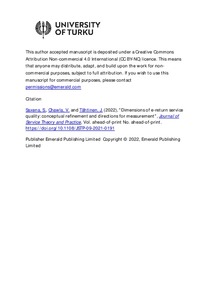Dimensions of e-return service quality: conceptual refinement and directions for measurement
Saxena Shilpi; Chawla Vaibhav; Tähtinen Jaana
https://urn.fi/URN:NBN:fi-fe2022081153778
Tiivistelmä
Purpose
Research regarding the quality of e-tailers’ service during product returns is sparse and the little that has been performed treats returns as recovery from failure. However, that view is outdated. E-tailers' product return practices have substantially evolved and customers' return behavior has considerably increased, in turn, influencing expectations of customers. Thus, a need arises to revise the understanding of how customers evaluate the quality of e-tailers' service during product returns. This study conceptualizes customer-perceived e-return service quality, identifies e-return's current dimensions, and offers directions for measurement.
Design/methodology/approach
This study is conducted in two stages. The first stage follows an abductive approach, with a continuous back-and-forth movement between existing theory and two qualitative data sets to identify the dimensions of e-return service quality. Scale development process is started in the second stage to offer directions for measurement based on the empirically grounded dimensions.
Findings
The conceptualization of e-return service quality identifies six dimensions: (1) owning of responsibility, (2) return convenience, (3) return remedies, (4) service team support, (5) site's return friendliness, and (6) returns diligence. The factor analysis supports the six-factor solution that can be employed for developing a valid scale in future.
Practical implications
The study suggests that e-tailers who are looking to differentiate themselves through superior e-return service quality should focus on customizing their service through excellent performance on these dimensions.
Originality/value
The paper updates and refines the understanding of service quality in the context of product returns service provided by e-tailers and thus offers a novel contribution.
Kokoelmat
- Rinnakkaistallenteet [27094]
